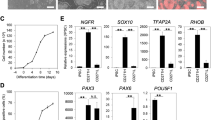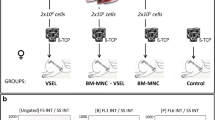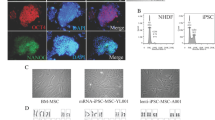Abstract
Stem cells (SCs) are known as undifferentiated cells with self-renewal and differentiation capacities. Regeneration is a phenomenon that occurs in a limited number of animals after injury, during which blastema tissue is formed. It has been hypothesized that upon injury, the dedifferentiation of surrounding tissues leads into the appearance of cells with SC characteristics. In present study, stem-like cells (SLCs) were obtained from regenerating tissue of New Zealand white rabbit’s pinna and their stemness properties were examined by their capacity to differentiate toward insulin producing cells (IPCs), as well as neural and osteogenic lineages. Differentiation was induced by culture of SLCs in defined medium, and cell fates were monitored by specific staining, RT-PCR and flow cytometry assays. Our results revealed that dithizone positive cells, which represent IPCs, and islet-like structures appeared 1 week after induction of SLCs, and this observation was confirmed by the elevated expression of Ins, Pax6 and Glut4 at mRNA level. Furthermore, SLCs were able to express neural markers as early as 1 week after retinoic acid treatment. Finally, SLCs were able to differentiate into osteogenic lineage, as confirmed by Alizarin Red S staining and RT-PCR studies. In conclusion, SLCs, which could successfully differentiate into cells derived from all three germ layers, can be considered as a valuable model to study developmental biology and regenerative medicine.







Similar content being viewed by others
References
Ahmadian Kia N, Bahrami AR, Ebrahimi M, Matin MM, Neshati Z, Almohaddesin MR, Aghdami N, Bidkhori HR (2011) Comparative analysis of chemokine receptor’s expression in mesenchymal stem cells derived from human bone marrow and adipose tissue. J Mol Neurosci 44:178–185
Andrews PW, Damjanov I, Simon D, Banting GS, Carlin C, Dracopoli NC, Føgh J (1984) Pluripotent embryonal carcinoma clones derived from the human teratocarcinoma cell line Tera-2. Differentiation in vivo and in vitro. Lab Invest 50:147–162
Baghaban Eslaminejad M, Bordbar S (2013) Isolation and characterization of the progenitor cells from the blastema tissue formed at experimentally-created rabbit ear hole. Iran J Basic Med Sci 16:109–115
Ben-David U, Benvenisty N (2011) The tumorigenicity of human embryonic and induced pluripotent stem cells. Nat Rev Cancer 11:268–277
Bissels U, Eckardt D, Bosio A (2013) Characterization and classification of stem cells. In: Steinhoff G (ed) Regenerative medicine: from protocol to patient. Springer, New York, pp 155–176
Bosch TC (2007a) Symmetry breaking in stem cells of the basal metazoan Hydra. Prog Mol Subcell Biol 45:61–78
Bosch TC (2007b) Why polyps regenerate and we don’t: towards a cellular and molecular framework for Hydra regeneration. Dev Biol 303:421–433
Brockes JP, Kumar A (2002) Plasticity and reprogramming of differentiated cells in amphibian regeneration. Nat Rev Mol Cell Biol 3:566–574
Brockes JP, Kumar A (2005) Appendage regeneration in adult vertebrates and implications for regenerative medicine. Science 310:1919–1923
Bryant SV, Endo T, Gardiner DM (2002) Vertebrate limb regeneration and the origin of limb stem cells. Int J Dev Biol 46:887–896
Carlson BM (2007) An introduction of regeneration. Principles of regenerative biology. Springer, San Diego, pp 6–29
Chen LB, Jiang XB, Yang L (2004) Differentiation of rat marrow mesenchymal stem cells into pancreatic islet beta-cells. World J Gastroenterol 10:3016–3020
Covas DT, Siufi JL, Silva AR, Orellana MD (2003) Isolation and culture of umbilical vein mesenchymal stem cells. Braz J Med Biol Res 36:1179–1183
Dantuma E, Merchant S, Sugaya K (2010) Stem cells for the treatment of neurodegenerative diseases. Stem Cell Res Ther 1:37
Dressel R, Schindehütte J, Kuhlmann T, Elsner L, Novota P, Baier PC, Schillert A, Bickeböller H, Herrmann T, Trenkwalder C, Paulus W, Mansouri A (2008) The tumorigenicity of mouse embryonic stem cells and in vitro differentiated neuronal cells is controlled by the recipients’ immune response. PLoS ONE 3:e2622
Edwards RG (2008) From embryonic stem cells to blastema and MRL mice. Reprod Biomed Online 16:425–461
Ehnert S, Glanemann M, Schmitt A, Vogt S, Shanny N, Nussler NC, Stöckle U, Nussler A (2009) The possible use of stem cells in regenerative medicine: dream or reality? Langenbecks Arch Surg 394:985–997
Evans M, Kaufman M (1981) Establishment in culture of pluripotent cells from mouse embryos. Nature 292:154–156
Galliot B, Miljkovic-Licina M, de Rosa R, Chera S (2006) Hydra, a niche for cell and developmental plasticity. Semin Cell Dev Biol 17:492–502
Gao F, Wu DQ, Hu YH, Jin GX (2008) Extracellular matrix gel is necessary for in vitro cultivation of insulin producing cells from human umbilical cord blood derived mesenchymal stem cells. Chin Med J 121:811–818
Gonzalez MA, Bernard A (2012) Characteristics of adult stem cells. Adv Exp Med Biol 741:103–120
Goss RJ, Grimes LN (1975) Epidermal downgrowths in regenerating rabbit ear holes. J Morphol 146:533–542
Han M, Yang X, Lee J, Allan CH, Muneoka K (2008) Development and regeneration of the neonatal digit tip in mice. Dev Biol 315:125–135
Kojima H, Fujimiya M, Matsumura K, Nakahara T, Hara M, Chan L (2004) Extrapancreatic insulin-producing cells in multiple organs in diabetes. Proc Natl Acad Sci USA 101:2458–2463
Kroon E, Martinson LA, Kadoya K, Bang AG, Kelly OG, Eliazer S, Young H, Richardson M, Smart NG, Cunningham J, Agulnick AD, D’Amour KA, Carpenter MK, Baetge EE (2008) Pancreatic endoderm derived from human embryonic stem cells generates glucose-responsive insulin-secreting cells in vivo. Nat Biotechnol 26:443–452
Lemischka I (1999) The power of stem cells reconsidered? Proc Natl Acad Sci USA 96:14193–14195
Li C, Zhao H, Liu Z, McMahon C (2014) Deer antler—a novel model for studying organ regeneration in mammals. Int J Biochem Cell Biol. http://dx.doi.org/10.1016/j.biocel.2014.07.007
Mahmoudi Z, Matin MM, Saeinasab M, Nakhaei-Rad S, Mirahmadi M, Mahdavi-Shahri N, Mahmoudi M, Bahrami AR (2011) Blastema cells from rabbit ear show stem cell characteristics. J Cell Mol Res 3:25–30
Martin GR (1981) Isolation of a pluripotent cell line from early mouse embryos cultured in medium conditioned by teratocarcinoma stem cells. Proc Natl Acad Sci USA 78:7634–7638
McBurney MW, Reuhl KR, Ally AI, Nasipuri S, Bell JC, Craiq J (1988) Differentiation and maturation of embryonal carcinoma-derived neurons in cell culture. J Neurosci 8:1063–1073
Neshati Z, Matin MM, Bahrami AR, Moghimi A (2010) Differentiation of mesenchymal stem cells to insulin-producing cells and their impact on type 1 diabetic rats. J Physiol Biochem 66:181–187
Odelberg SJ (2004) Unraveling the molecular basis for regenerative cellular plasticity. PLoS Biol 2:E232
Odelberg SJ (2005) Cellular plasticity in vertebrate regeneration. Anat Rec B New Anat 287B:25–35
Pacherník J, Bryja V, Esner M, Hampl A, Dvorák P (2005) Retinoic acid-induced neural differentiation of P19 embryonal carcinoma cells is potentiated by leukemia inhibitory factor. Physiol Res 54:257–262
Patel AN, Genovese J (2011) Potential clinical applications of adult human mesenchymal stem cell (Prochymal®) therapy. Stem Cells Cloning 4:61–72
Poss KD (2007) Getting to the heart of regeneration in zebrafish. Semin Cell Dev Biol 18:36–45
Poss KD, Keating MT, Nechiporuk A (2003) Tales of regeneration in zebrafish. Dev Dyn 226:202–210
Poulsom R, Alison MR, Forbes SJ, Wright NA (2002) Adult stem cell plasticity. J Pathol 197:441–456
Reddien PW, Sánchez Alvarado A (2004) Fundamentals of planarian regeneration. Annu Rev Cell Dev Biol 20:725–757
Rezania A, Bruin JE, Riedel MJ, Mojibian M, Asadi A, Xu J, Gauvin R, Narayan K, Karanu F, O’Neil JJ, Ao Z, Warnock GL, Kieffer TJ (2012) Maturation of human embryonic stem cell derived pancreatic progenitors into functional islets capable of treating preexisting diabetes in mice. Diabetes 61:2016–2029
Rohweddel J, Guan K, Wobus AM (1999) Induction of cellular differentiation by retinoic acid in vitro. Cell Tissue Organs 165:190–202
Rosner M, Schipany K, Hengstschläger M (2014) The decision on the “optimal” human pluripotent stem cell. Stem Cells Transl Med 3:553–559
Schulz TC, Young HY, Agulnick AD, Babin MJ, Baetge EE, Bang AG, Bhoumik A, Cepa I, Cesario RM, Haakmeester C, Kadoya K, Kelly JR, Kerr J, Martinson LA, McLean AB, Moorman MA, Payne JK, Richardson M, Ross KG, Sherrer ES, Song X, Wilson AZ, Brandon EP, Green CE, Kroon EJ, Kelly OG, D’Amour KA, Robins AJ (2012) A scalable system for production of functional pancreatic progenitors from human embryonic stem cells. PLoS ONE 7:e37004
Shiroi A, Yoshikawa M, Yokota H, Fukui H, Ishizaka S, Tatsumi K, Takahashi Y (2002) Identification of insulin-producing cells derived from embryonic stem cells by zinc-chelating dithizone. Stem Cells 20:284–292
Staines WA, Morassutti DJ, Reuhl KR, Alley AI, McBurney MW (1994) Neurons derived from P19 embryonal carcinoma cells have varied morphologies and neurotransmitters. Neurosciences 58:735–751
Stocum DL (2012) Regeneration of appendages. Regenerative biology and medicine, 2nd edn. Springer, San Diego, pp 363–404
Sun NZ, Ji H (2012) In vitro differentiation of osteocytes and adipocytes from human placenta-derived cells. J Int Med Res 40:761–767
Sun Y, Chen L, Hou XG, Hou WK, Dong JJ, Sun L, Tang KX, Wang B, Song J, Li H, Wang KX (2007) Differentiation of bone marrow-derived mesenchymal stem cells from diabetic patients into insulin-producing cells in vitro. Chin Med J 120:771–776
Suzuki M, Yakushiji N, Nakada Y, Satoh A, Ide H, Tamura K (2006) Limb regeneration in Xenopus laevis froglet. ScientificWorldJournal 6:26–37
Teng M, Huang Y, Zhang H (2014) Application of stems cells in wound healing—an update. Wound Repair Regen 22:151–160
Tsonis PA (2000) Regeneration in vertebrates. Dev Biol 221:273–284
Vazin T, Freed WJ (2010) Human embryonic stem cells: derivation, culture, and differentiation: a review. Restor Neurol Neurosci 28:589–603
Watt FM, Hogan BLM (2000) Out of eden: stem cells and their niches. Science 287:1427–1430
William-Boyce PK, Daniel JC (1980) Comparison of ear tissue regeneration in mammals. J Anat 149:55–63
Yokoyama H (2008) Initiation of limb regeneration: the critical steps for regenerative capacity. Dev Growth Differ 50:13–22
Zalzman M, Gupta S, Giri RK, Berkovich I, Sappal BS, Karnieli O, Zern MA, Fleischer N, Efrat S (2003) Reversal of hyperglycemia in mice by using human expandable insulin-producing cells differentiated from fetal liver progenitor cells. Proc Natl Acad Sci USA 100:7253–7258
Acknowledgments
This work was supported by a Grant (No. 6660) from Ferdowsi University of Mashhad, Iran. The authors are grateful to Dr. M.M. Ejtehadi (Dr. Ejtehadi Medical Lab. Center) and Mrs. Z. Neshati for their great technical support and scientific advice.
Author information
Authors and Affiliations
Corresponding author
Rights and permissions
About this article
Cite this article
Saeinasab, M., Matin, M.M., Rassouli, F.B. et al. Blastema cells derived from New Zealand white rabbit’s pinna carry stemness properties as shown by differentiation into insulin producing, neural, and osteogenic lineages representing three embryonic germ layers. Cytotechnology 68, 497–507 (2016). https://doi.org/10.1007/s10616-014-9802-4
Received:
Accepted:
Published:
Issue Date:
DOI: https://doi.org/10.1007/s10616-014-9802-4




